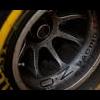BMW M4 GTS gets world's first water-injected engine, OLED tail lights
BMW M4 GTS gets world's first water-injected engine, OLED tail lights

 The 2016 BMW M4 GTS Coupe boasts two production car world-firsts: a water-injected engine in the front and organic light emitting diode (OLED) tail lights in the rear.
The 2016 BMW M4 GTS Coupe boasts two production car world-firsts: a water-injected engine in the front and organic light emitting diode (OLED) tail lights in the rear.
BMW engineers have taken their 3.0-liter twin-turbocharged inline 6-cylinder and, for the first time in a production car, fitted it with water injection. Though the technology has been utilized and proven on the racetrack for many years, this is the first production car to include it. It has many technical benefits. Essentially, injecting water in the cylinder along with a tiny mist of gasoline allows the engine to run at higher rpm than without the water. And, as we learned during dieselgate, higher compression engines not only run more efficiently, they also generate more power.
The result of adding water injection to the M4 motor is a 16% bump in horsepower and a 10% increase in torque, totaling 493 hp and 442 pound-feet. These performance figures will rocket the M4 GTS from 0 to 60 mph in 3.7 seconds on the way to its top speed of 189.5 mph. All that power is routed to the rear wheels through the 7-speed M double-clutch transmission and the active M rear differential. Amazingly, the car is capable of generating all this extra oomph while returning similar fuel efficiency numbers as the 'standard' M4 coupe.
As for the rear-end tech, while not as mighty as the engine, the OLED lights are nonetheless impressive. Compared to LED lights common in high-end cars, OLED are incredibly thin and emit light across the entire surface, rather than from a single point. Not only does this mean the lights are 1.4 mm tall but they can light up modules individually, creating "fresh possibilities ... and distinctive BMW lighting design -– both at night and daylight," according to BMW.
The front and rear aren't the only spots with cool features on the M4 GTS, the middle has some distinguishing characteristics, too. BMW was keen to cut weight on the GTS, so its carved several components from carbon-fiber-reinforced plastic (CFRP), including the roof, hood, instrument panel, and that massive rear wing. It's also deleted the rear seats and installed a new suspension that is not only lighter weight but also three-way adjustable. The total weight savings result is a curb weight of just 3,494 pounds — 36 pounds lighter than the standard M4. Designers finished the whole thing off with a dark matte paint scheme and added a touch of flare with the BMW M star-spoke wheels with Acid Orange highlights.
BMW will only be producing 700 examples worldwide, of which, 300 units will be rolled out for the U.S. market first.







1 Comment
Recommended Comments
Create an account or sign in to comment
You need to be a member in order to leave a comment
Create an account
Sign up for a new account in our community. It's easy!
Register a new accountSign in
Already have an account? Sign in here.
Sign In Now